Entrepreneurial Ventures, Micro and Small Business Impact Report
VerifiedAdded on 2023/01/19
|13
|2692
|79
Report
AI Summary
This report delves into the realm of entrepreneurship, examining various entrepreneurial ventures, including those in the private and public sectors, such as small businesses, scalable start-ups, large companies, and social enterprises. It differentiates between entrepreneurial ventures, highlighting the unique characteristics of male, female, lifestyle, and serial entrepreneurs. The report then assesses the influence of micro and small businesses on the economy, exploring their impact on management structure, employee growth, and overall economic contribution. Furthermore, it underscores the importance of small businesses and start-ups for the growth of the social economy, emphasizing their role in fostering competition, generating job opportunities, and spreading awareness. The report concludes with a summary of the findings, highlighting the crucial role of small businesses and entrepreneurs in national development and unemployment reduction.

ENTREPRENEURSHIP
AND SMALL
BUISNESS
MANAGEMENT
AND SMALL
BUISNESS
MANAGEMENT
Paraphrase This Document
Need a fresh take? Get an instant paraphrase of this document with our AI Paraphraser
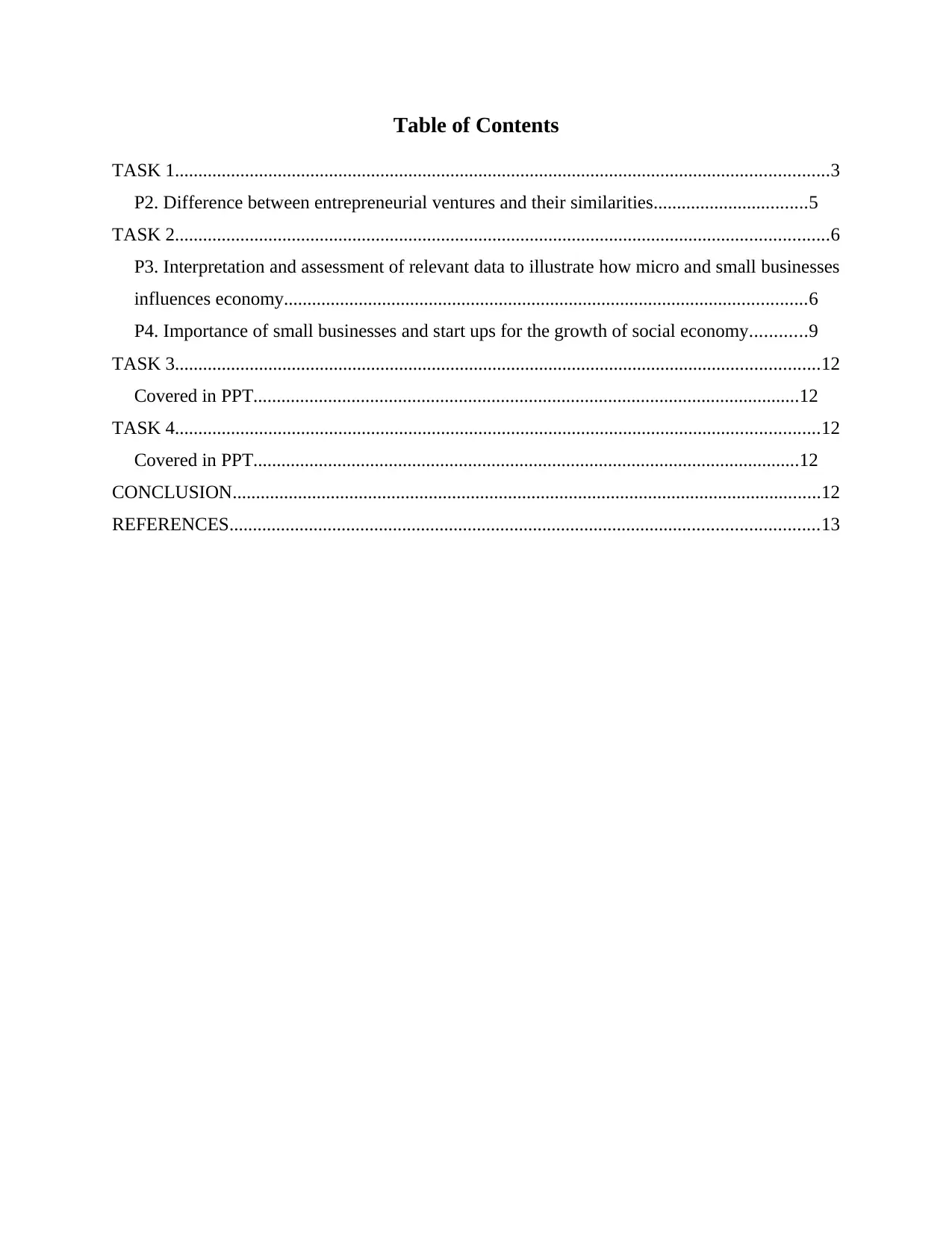
Table of Contents
TASK 1............................................................................................................................................3
P2. Difference between entrepreneurial ventures and their similarities.................................5
TASK 2............................................................................................................................................6
P3. Interpretation and assessment of relevant data to illustrate how micro and small businesses
influences economy................................................................................................................6
P4. Importance of small businesses and start ups for the growth of social economy............9
TASK 3..........................................................................................................................................12
Covered in PPT.....................................................................................................................12
TASK 4..........................................................................................................................................12
Covered in PPT.....................................................................................................................12
CONCLUSION..............................................................................................................................12
REFERENCES..............................................................................................................................13
TASK 1............................................................................................................................................3
P2. Difference between entrepreneurial ventures and their similarities.................................5
TASK 2............................................................................................................................................6
P3. Interpretation and assessment of relevant data to illustrate how micro and small businesses
influences economy................................................................................................................6
P4. Importance of small businesses and start ups for the growth of social economy............9
TASK 3..........................................................................................................................................12
Covered in PPT.....................................................................................................................12
TASK 4..........................................................................................................................................12
Covered in PPT.....................................................................................................................12
CONCLUSION..............................................................................................................................12
REFERENCES..............................................................................................................................13
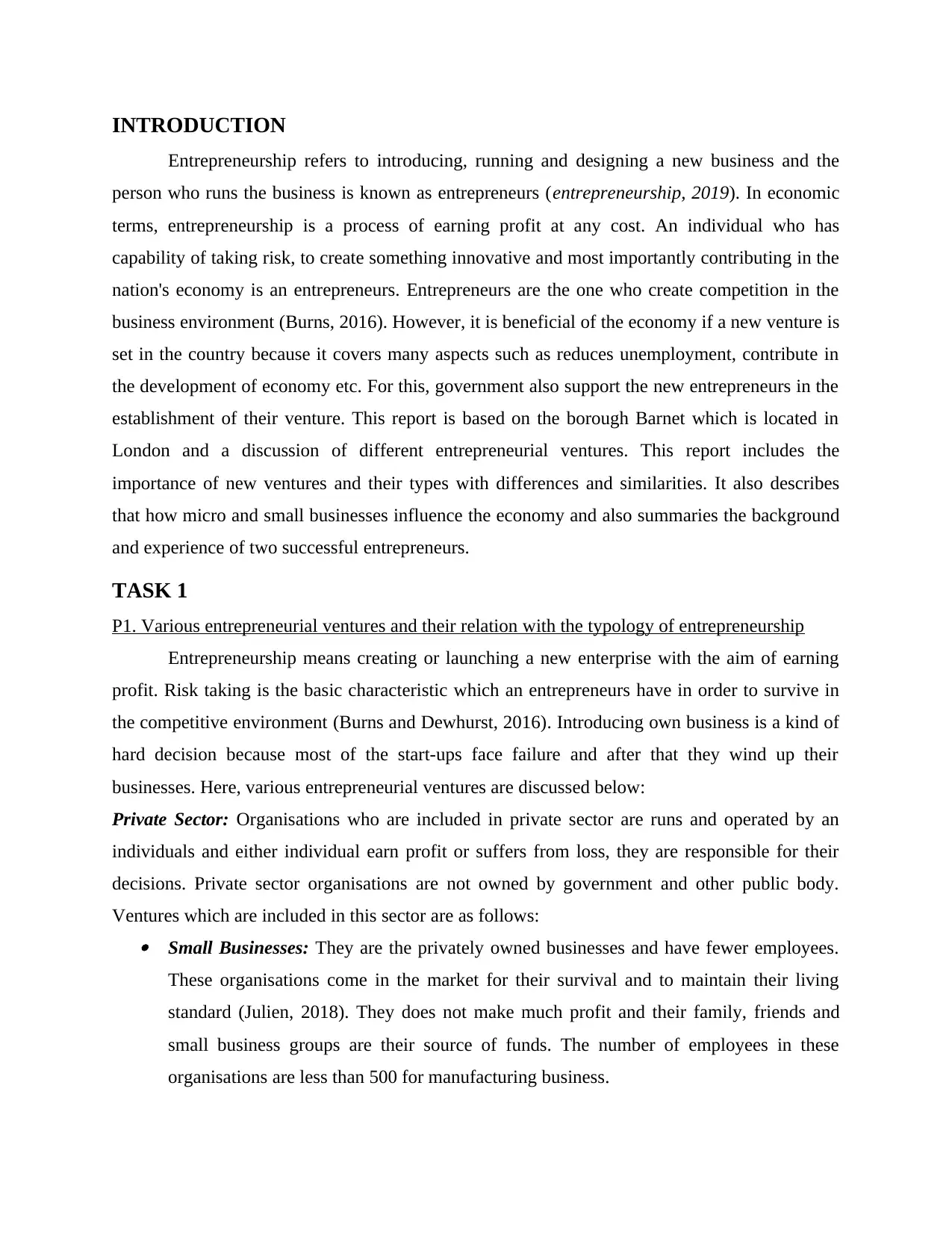
INTRODUCTION
Entrepreneurship refers to introducing, running and designing a new business and the
person who runs the business is known as entrepreneurs (entrepreneurship, 2019). In economic
terms, entrepreneurship is a process of earning profit at any cost. An individual who has
capability of taking risk, to create something innovative and most importantly contributing in the
nation's economy is an entrepreneurs. Entrepreneurs are the one who create competition in the
business environment (Burns, 2016). However, it is beneficial of the economy if a new venture is
set in the country because it covers many aspects such as reduces unemployment, contribute in
the development of economy etc. For this, government also support the new entrepreneurs in the
establishment of their venture. This report is based on the borough Barnet which is located in
London and a discussion of different entrepreneurial ventures. This report includes the
importance of new ventures and their types with differences and similarities. It also describes
that how micro and small businesses influence the economy and also summaries the background
and experience of two successful entrepreneurs.
TASK 1
P1. Various entrepreneurial ventures and their relation with the typology of entrepreneurship
Entrepreneurship means creating or launching a new enterprise with the aim of earning
profit. Risk taking is the basic characteristic which an entrepreneurs have in order to survive in
the competitive environment (Burns and Dewhurst, 2016). Introducing own business is a kind of
hard decision because most of the start-ups face failure and after that they wind up their
businesses. Here, various entrepreneurial ventures are discussed below:
Private Sector: Organisations who are included in private sector are runs and operated by an
individuals and either individual earn profit or suffers from loss, they are responsible for their
decisions. Private sector organisations are not owned by government and other public body.
Ventures which are included in this sector are as follows: Small Businesses: They are the privately owned businesses and have fewer employees.
These organisations come in the market for their survival and to maintain their living
standard (Julien, 2018). They does not make much profit and their family, friends and
small business groups are their source of funds. The number of employees in these
organisations are less than 500 for manufacturing business.
Entrepreneurship refers to introducing, running and designing a new business and the
person who runs the business is known as entrepreneurs (entrepreneurship, 2019). In economic
terms, entrepreneurship is a process of earning profit at any cost. An individual who has
capability of taking risk, to create something innovative and most importantly contributing in the
nation's economy is an entrepreneurs. Entrepreneurs are the one who create competition in the
business environment (Burns, 2016). However, it is beneficial of the economy if a new venture is
set in the country because it covers many aspects such as reduces unemployment, contribute in
the development of economy etc. For this, government also support the new entrepreneurs in the
establishment of their venture. This report is based on the borough Barnet which is located in
London and a discussion of different entrepreneurial ventures. This report includes the
importance of new ventures and their types with differences and similarities. It also describes
that how micro and small businesses influence the economy and also summaries the background
and experience of two successful entrepreneurs.
TASK 1
P1. Various entrepreneurial ventures and their relation with the typology of entrepreneurship
Entrepreneurship means creating or launching a new enterprise with the aim of earning
profit. Risk taking is the basic characteristic which an entrepreneurs have in order to survive in
the competitive environment (Burns and Dewhurst, 2016). Introducing own business is a kind of
hard decision because most of the start-ups face failure and after that they wind up their
businesses. Here, various entrepreneurial ventures are discussed below:
Private Sector: Organisations who are included in private sector are runs and operated by an
individuals and either individual earn profit or suffers from loss, they are responsible for their
decisions. Private sector organisations are not owned by government and other public body.
Ventures which are included in this sector are as follows: Small Businesses: They are the privately owned businesses and have fewer employees.
These organisations come in the market for their survival and to maintain their living
standard (Julien, 2018). They does not make much profit and their family, friends and
small business groups are their source of funds. The number of employees in these
organisations are less than 500 for manufacturing business.
⊘ This is a preview!⊘
Do you want full access?
Subscribe today to unlock all pages.

Trusted by 1+ million students worldwide
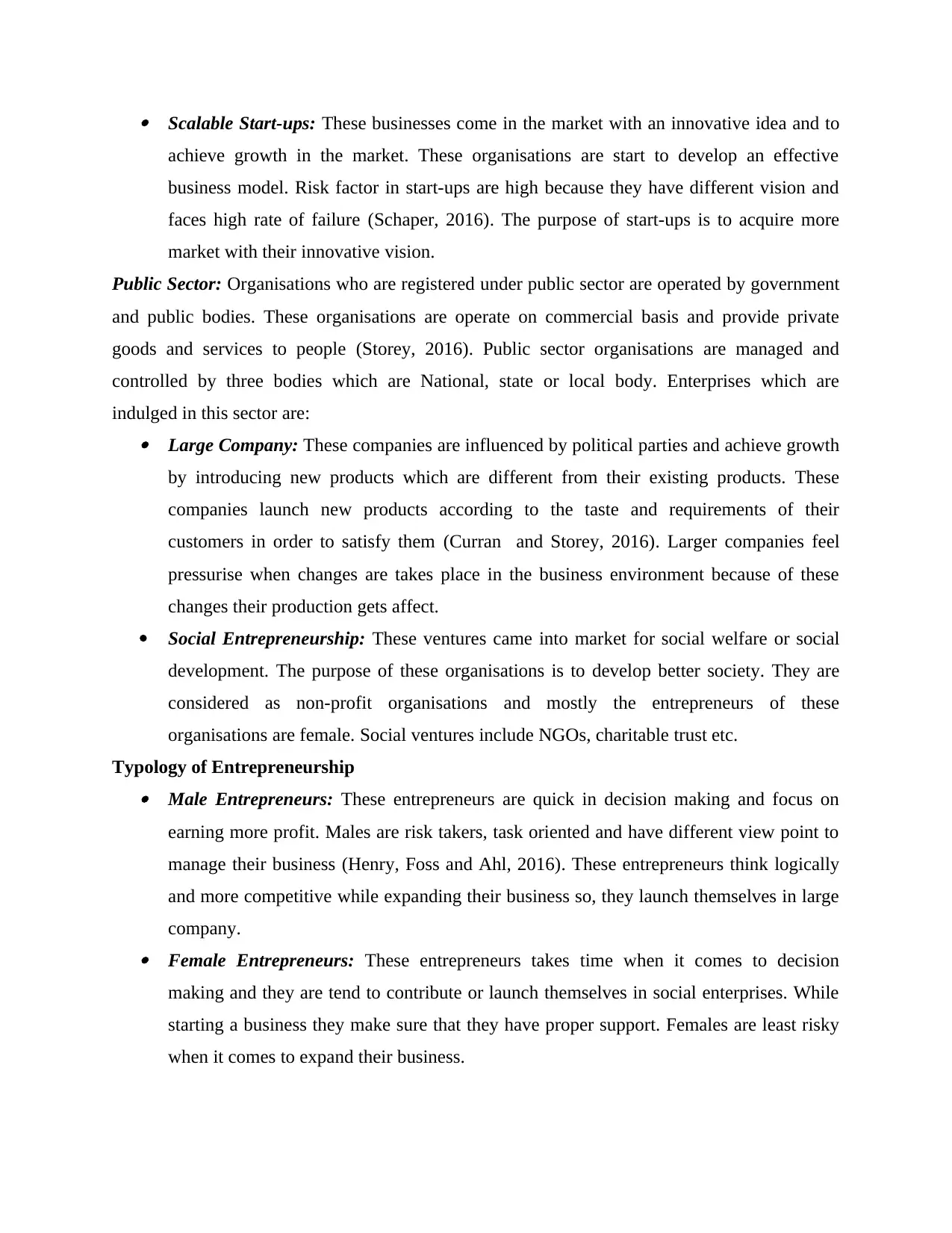
Scalable Start-ups: These businesses come in the market with an innovative idea and to
achieve growth in the market. These organisations are start to develop an effective
business model. Risk factor in start-ups are high because they have different vision and
faces high rate of failure (Schaper, 2016). The purpose of start-ups is to acquire more
market with their innovative vision.
Public Sector: Organisations who are registered under public sector are operated by government
and public bodies. These organisations are operate on commercial basis and provide private
goods and services to people (Storey, 2016). Public sector organisations are managed and
controlled by three bodies which are National, state or local body. Enterprises which are
indulged in this sector are: Large Company: These companies are influenced by political parties and achieve growth
by introducing new products which are different from their existing products. These
companies launch new products according to the taste and requirements of their
customers in order to satisfy them (Curran and Storey, 2016). Larger companies feel
pressurise when changes are takes place in the business environment because of these
changes their production gets affect.
Social Entrepreneurship: These ventures came into market for social welfare or social
development. The purpose of these organisations is to develop better society. They are
considered as non-profit organisations and mostly the entrepreneurs of these
organisations are female. Social ventures include NGOs, charitable trust etc.
Typology of Entrepreneurship Male Entrepreneurs: These entrepreneurs are quick in decision making and focus on
earning more profit. Males are risk takers, task oriented and have different view point to
manage their business (Henry, Foss and Ahl, 2016). These entrepreneurs think logically
and more competitive while expanding their business so, they launch themselves in large
company. Female Entrepreneurs: These entrepreneurs takes time when it comes to decision
making and they are tend to contribute or launch themselves in social enterprises. While
starting a business they make sure that they have proper support. Females are least risky
when it comes to expand their business.
achieve growth in the market. These organisations are start to develop an effective
business model. Risk factor in start-ups are high because they have different vision and
faces high rate of failure (Schaper, 2016). The purpose of start-ups is to acquire more
market with their innovative vision.
Public Sector: Organisations who are registered under public sector are operated by government
and public bodies. These organisations are operate on commercial basis and provide private
goods and services to people (Storey, 2016). Public sector organisations are managed and
controlled by three bodies which are National, state or local body. Enterprises which are
indulged in this sector are: Large Company: These companies are influenced by political parties and achieve growth
by introducing new products which are different from their existing products. These
companies launch new products according to the taste and requirements of their
customers in order to satisfy them (Curran and Storey, 2016). Larger companies feel
pressurise when changes are takes place in the business environment because of these
changes their production gets affect.
Social Entrepreneurship: These ventures came into market for social welfare or social
development. The purpose of these organisations is to develop better society. They are
considered as non-profit organisations and mostly the entrepreneurs of these
organisations are female. Social ventures include NGOs, charitable trust etc.
Typology of Entrepreneurship Male Entrepreneurs: These entrepreneurs are quick in decision making and focus on
earning more profit. Males are risk takers, task oriented and have different view point to
manage their business (Henry, Foss and Ahl, 2016). These entrepreneurs think logically
and more competitive while expanding their business so, they launch themselves in large
company. Female Entrepreneurs: These entrepreneurs takes time when it comes to decision
making and they are tend to contribute or launch themselves in social enterprises. While
starting a business they make sure that they have proper support. Females are least risky
when it comes to expand their business.
Paraphrase This Document
Need a fresh take? Get an instant paraphrase of this document with our AI Paraphraser
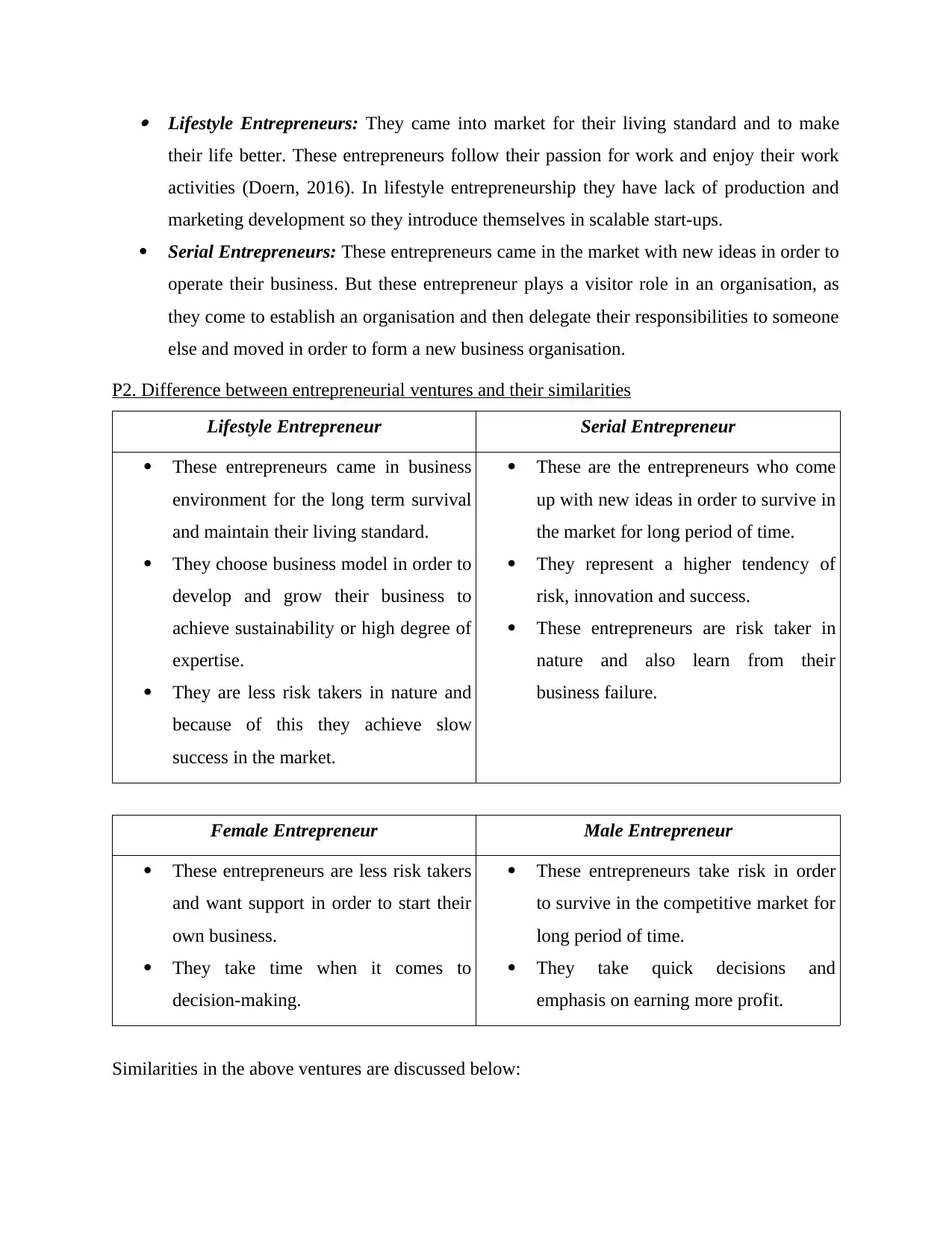
Lifestyle Entrepreneurs: They came into market for their living standard and to make
their life better. These entrepreneurs follow their passion for work and enjoy their work
activities (Doern, 2016). In lifestyle entrepreneurship they have lack of production and
marketing development so they introduce themselves in scalable start-ups.
Serial Entrepreneurs: These entrepreneurs came in the market with new ideas in order to
operate their business. But these entrepreneur plays a visitor role in an organisation, as
they come to establish an organisation and then delegate their responsibilities to someone
else and moved in order to form a new business organisation.
P2. Difference between entrepreneurial ventures and their similarities
Lifestyle Entrepreneur Serial Entrepreneur
These entrepreneurs came in business
environment for the long term survival
and maintain their living standard.
They choose business model in order to
develop and grow their business to
achieve sustainability or high degree of
expertise.
They are less risk takers in nature and
because of this they achieve slow
success in the market.
These are the entrepreneurs who come
up with new ideas in order to survive in
the market for long period of time.
They represent a higher tendency of
risk, innovation and success.
These entrepreneurs are risk taker in
nature and also learn from their
business failure.
Female Entrepreneur Male Entrepreneur
These entrepreneurs are less risk takers
and want support in order to start their
own business.
They take time when it comes to
decision-making.
These entrepreneurs take risk in order
to survive in the competitive market for
long period of time.
They take quick decisions and
emphasis on earning more profit.
Similarities in the above ventures are discussed below:
their life better. These entrepreneurs follow their passion for work and enjoy their work
activities (Doern, 2016). In lifestyle entrepreneurship they have lack of production and
marketing development so they introduce themselves in scalable start-ups.
Serial Entrepreneurs: These entrepreneurs came in the market with new ideas in order to
operate their business. But these entrepreneur plays a visitor role in an organisation, as
they come to establish an organisation and then delegate their responsibilities to someone
else and moved in order to form a new business organisation.
P2. Difference between entrepreneurial ventures and their similarities
Lifestyle Entrepreneur Serial Entrepreneur
These entrepreneurs came in business
environment for the long term survival
and maintain their living standard.
They choose business model in order to
develop and grow their business to
achieve sustainability or high degree of
expertise.
They are less risk takers in nature and
because of this they achieve slow
success in the market.
These are the entrepreneurs who come
up with new ideas in order to survive in
the market for long period of time.
They represent a higher tendency of
risk, innovation and success.
These entrepreneurs are risk taker in
nature and also learn from their
business failure.
Female Entrepreneur Male Entrepreneur
These entrepreneurs are less risk takers
and want support in order to start their
own business.
They take time when it comes to
decision-making.
These entrepreneurs take risk in order
to survive in the competitive market for
long period of time.
They take quick decisions and
emphasis on earning more profit.
Similarities in the above ventures are discussed below:
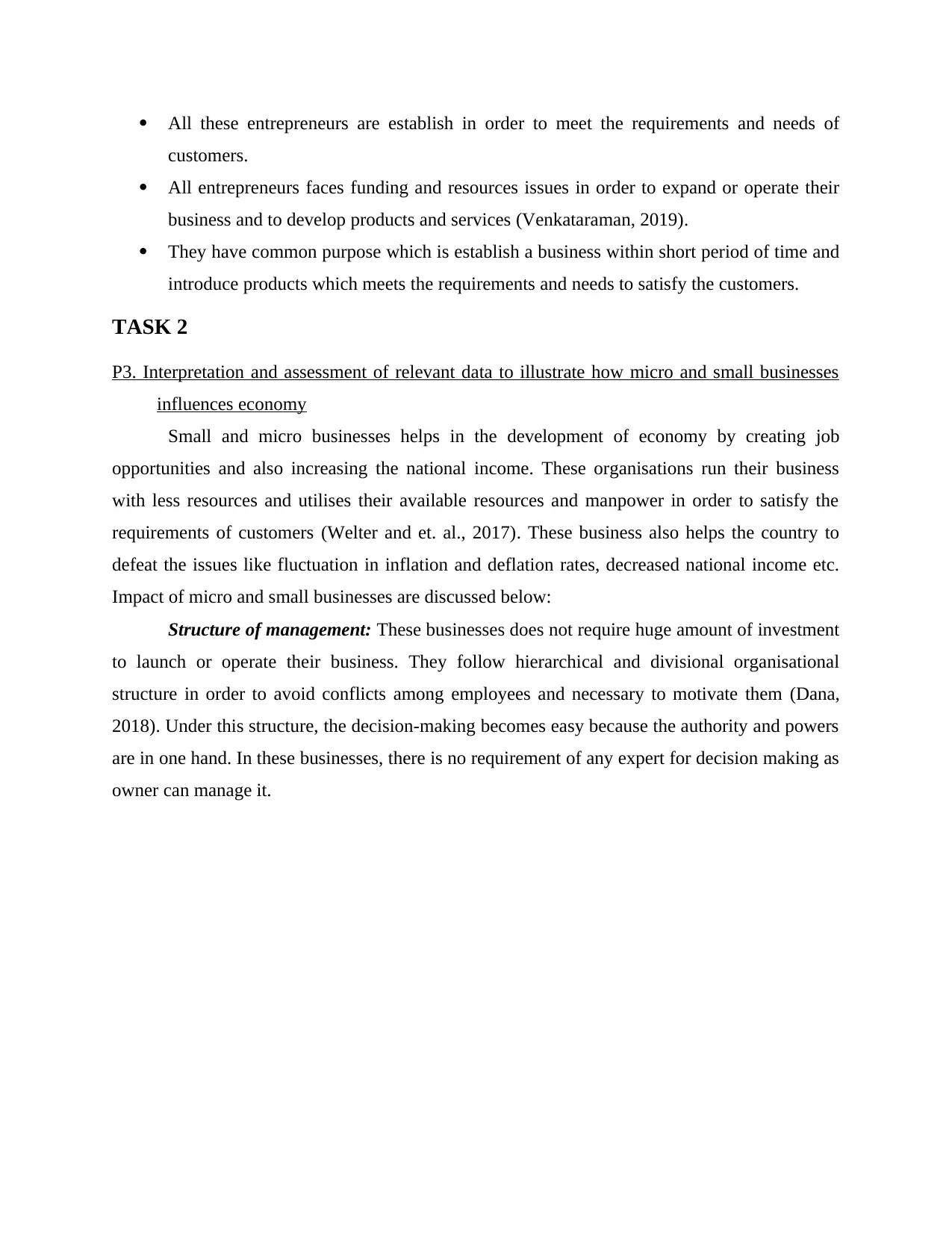
All these entrepreneurs are establish in order to meet the requirements and needs of
customers.
All entrepreneurs faces funding and resources issues in order to expand or operate their
business and to develop products and services (Venkataraman, 2019).
They have common purpose which is establish a business within short period of time and
introduce products which meets the requirements and needs to satisfy the customers.
TASK 2
P3. Interpretation and assessment of relevant data to illustrate how micro and small businesses
influences economy
Small and micro businesses helps in the development of economy by creating job
opportunities and also increasing the national income. These organisations run their business
with less resources and utilises their available resources and manpower in order to satisfy the
requirements of customers (Welter and et. al., 2017). These business also helps the country to
defeat the issues like fluctuation in inflation and deflation rates, decreased national income etc.
Impact of micro and small businesses are discussed below:
Structure of management: These businesses does not require huge amount of investment
to launch or operate their business. They follow hierarchical and divisional organisational
structure in order to avoid conflicts among employees and necessary to motivate them (Dana,
2018). Under this structure, the decision-making becomes easy because the authority and powers
are in one hand. In these businesses, there is no requirement of any expert for decision making as
owner can manage it.
customers.
All entrepreneurs faces funding and resources issues in order to expand or operate their
business and to develop products and services (Venkataraman, 2019).
They have common purpose which is establish a business within short period of time and
introduce products which meets the requirements and needs to satisfy the customers.
TASK 2
P3. Interpretation and assessment of relevant data to illustrate how micro and small businesses
influences economy
Small and micro businesses helps in the development of economy by creating job
opportunities and also increasing the national income. These organisations run their business
with less resources and utilises their available resources and manpower in order to satisfy the
requirements of customers (Welter and et. al., 2017). These business also helps the country to
defeat the issues like fluctuation in inflation and deflation rates, decreased national income etc.
Impact of micro and small businesses are discussed below:
Structure of management: These businesses does not require huge amount of investment
to launch or operate their business. They follow hierarchical and divisional organisational
structure in order to avoid conflicts among employees and necessary to motivate them (Dana,
2018). Under this structure, the decision-making becomes easy because the authority and powers
are in one hand. In these businesses, there is no requirement of any expert for decision making as
owner can manage it.
⊘ This is a preview!⊘
Do you want full access?
Subscribe today to unlock all pages.

Trusted by 1+ million students worldwide
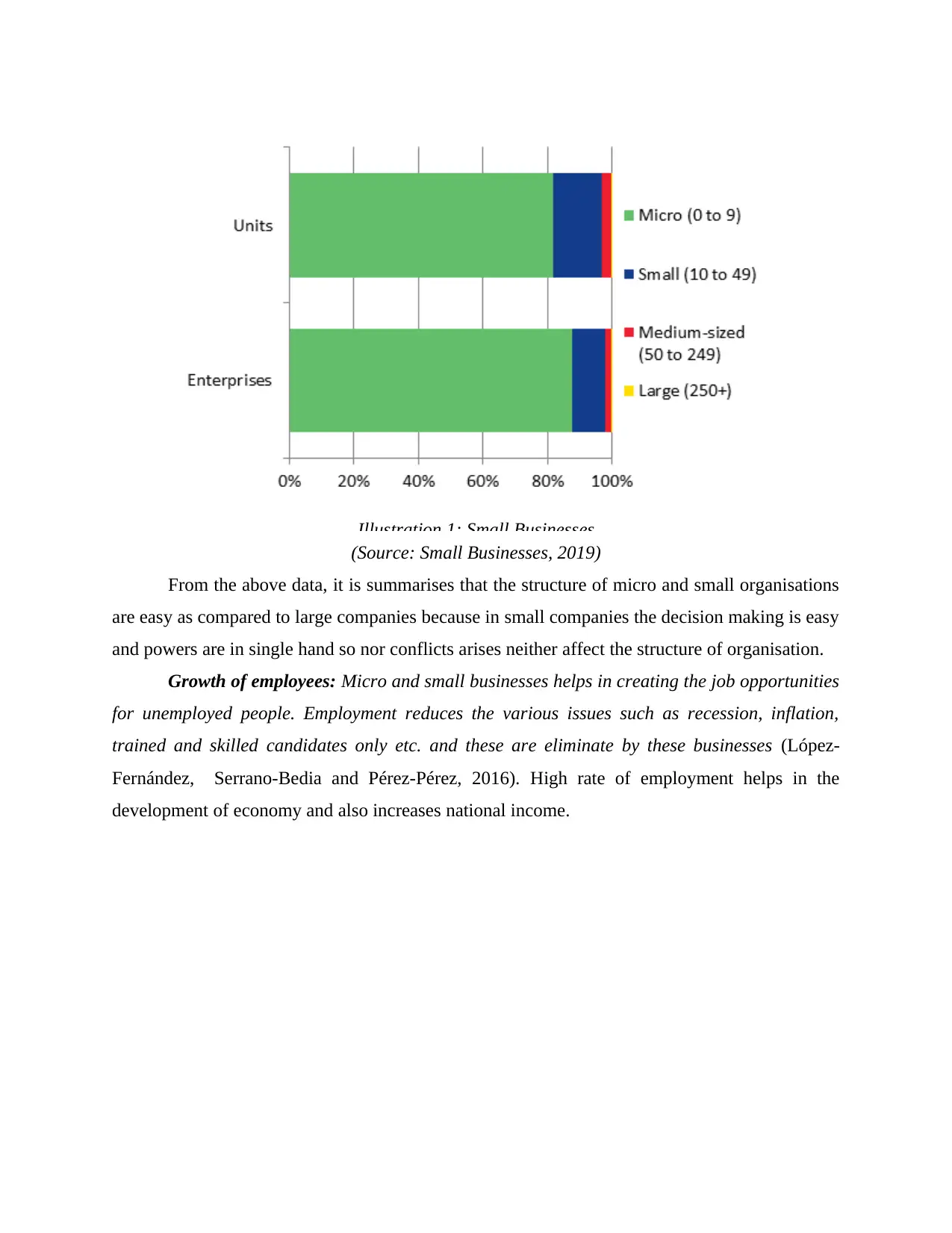
Illustration 1: Small Businesses
(Source: Small Businesses, 2019)
From the above data, it is summarises that the structure of micro and small organisations
are easy as compared to large companies because in small companies the decision making is easy
and powers are in single hand so nor conflicts arises neither affect the structure of organisation.
Growth of employees: Micro and small businesses helps in creating the job opportunities
for unemployed people. Employment reduces the various issues such as recession, inflation,
trained and skilled candidates only etc. and these are eliminate by these businesses (López‐
Fernández, Serrano‐Bedia and Pérez‐Pérez, 2016). High rate of employment helps in the
development of economy and also increases national income.
(Source: Small Businesses, 2019)
From the above data, it is summarises that the structure of micro and small organisations
are easy as compared to large companies because in small companies the decision making is easy
and powers are in single hand so nor conflicts arises neither affect the structure of organisation.
Growth of employees: Micro and small businesses helps in creating the job opportunities
for unemployed people. Employment reduces the various issues such as recession, inflation,
trained and skilled candidates only etc. and these are eliminate by these businesses (López‐
Fernández, Serrano‐Bedia and Pérez‐Pérez, 2016). High rate of employment helps in the
development of economy and also increases national income.
Paraphrase This Document
Need a fresh take? Get an instant paraphrase of this document with our AI Paraphraser
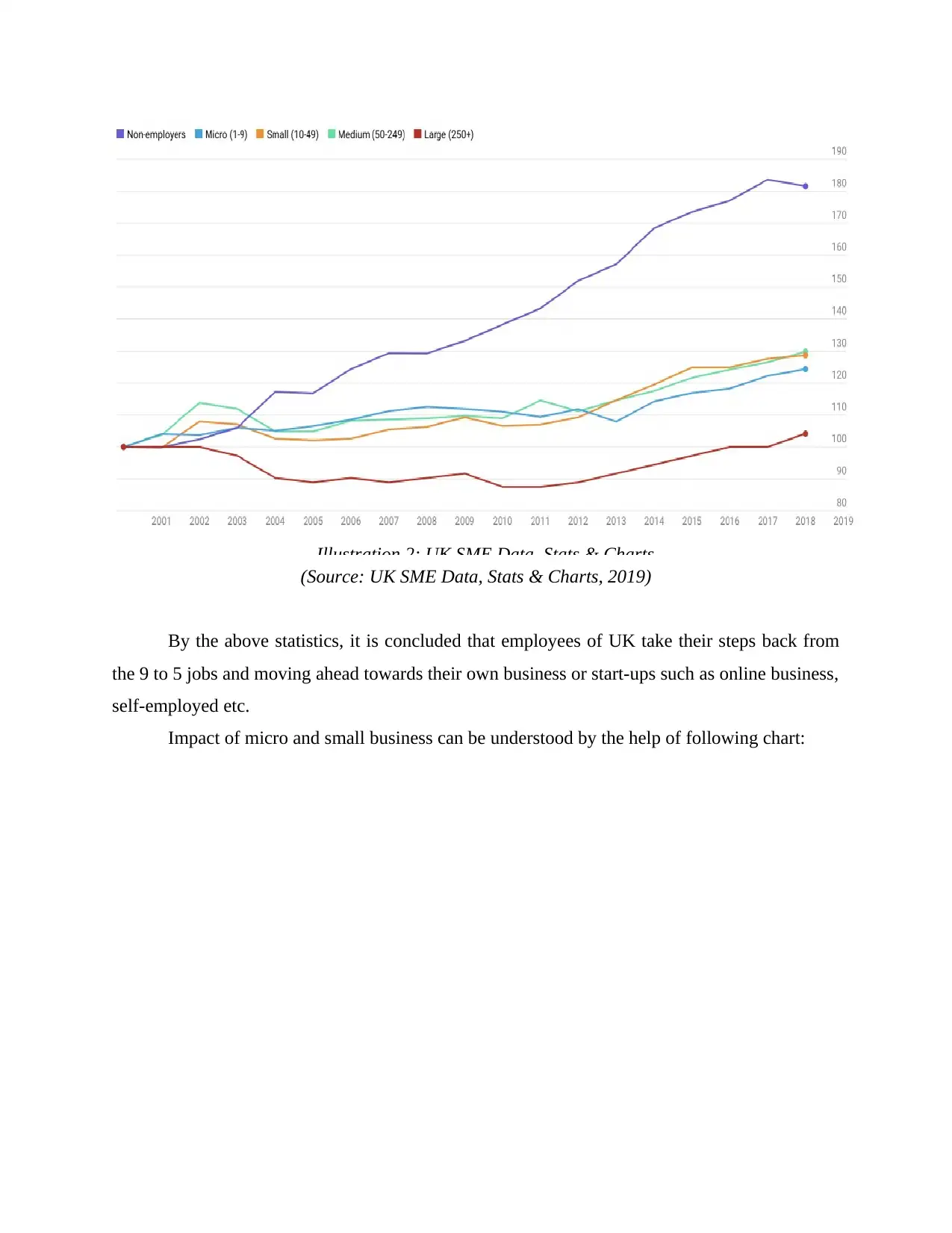
Illustration 2: UK SME Data, Stats & Charts
(Source: UK SME Data, Stats & Charts, 2019)
By the above statistics, it is concluded that employees of UK take their steps back from
the 9 to 5 jobs and moving ahead towards their own business or start-ups such as online business,
self-employed etc.
Impact of micro and small business can be understood by the help of following chart:
(Source: UK SME Data, Stats & Charts, 2019)
By the above statistics, it is concluded that employees of UK take their steps back from
the 9 to 5 jobs and moving ahead towards their own business or start-ups such as online business,
self-employed etc.
Impact of micro and small business can be understood by the help of following chart:
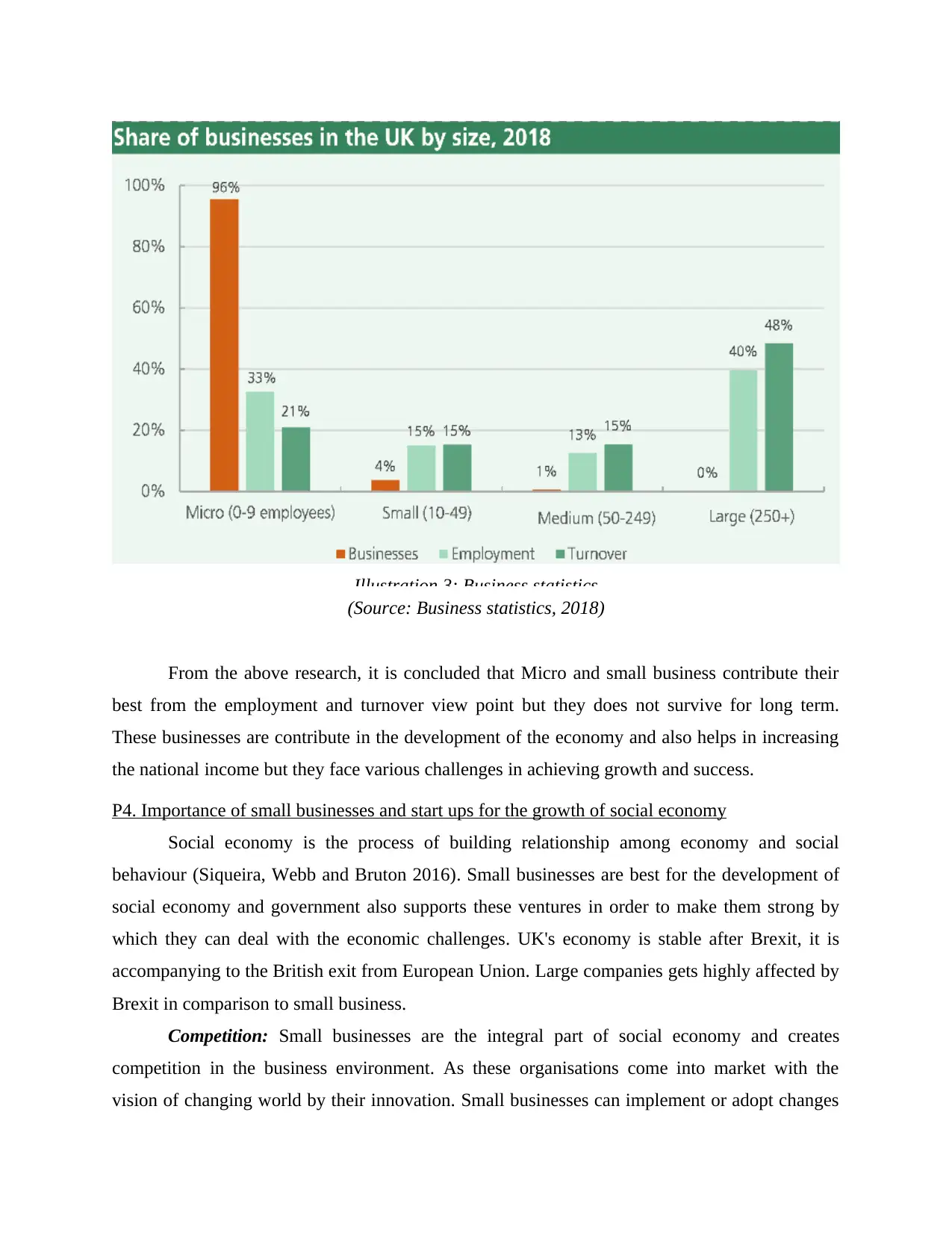
Illustration 3: Business statistics
(Source: Business statistics, 2018)
From the above research, it is concluded that Micro and small business contribute their
best from the employment and turnover view point but they does not survive for long term.
These businesses are contribute in the development of the economy and also helps in increasing
the national income but they face various challenges in achieving growth and success.
P4. Importance of small businesses and start ups for the growth of social economy
Social economy is the process of building relationship among economy and social
behaviour (Siqueira, Webb and Bruton 2016). Small businesses are best for the development of
social economy and government also supports these ventures in order to make them strong by
which they can deal with the economic challenges. UK's economy is stable after Brexit, it is
accompanying to the British exit from European Union. Large companies gets highly affected by
Brexit in comparison to small business.
Competition: Small businesses are the integral part of social economy and creates
competition in the business environment. As these organisations come into market with the
vision of changing world by their innovation. Small businesses can implement or adopt changes
(Source: Business statistics, 2018)
From the above research, it is concluded that Micro and small business contribute their
best from the employment and turnover view point but they does not survive for long term.
These businesses are contribute in the development of the economy and also helps in increasing
the national income but they face various challenges in achieving growth and success.
P4. Importance of small businesses and start ups for the growth of social economy
Social economy is the process of building relationship among economy and social
behaviour (Siqueira, Webb and Bruton 2016). Small businesses are best for the development of
social economy and government also supports these ventures in order to make them strong by
which they can deal with the economic challenges. UK's economy is stable after Brexit, it is
accompanying to the British exit from European Union. Large companies gets highly affected by
Brexit in comparison to small business.
Competition: Small businesses are the integral part of social economy and creates
competition in the business environment. As these organisations come into market with the
vision of changing world by their innovation. Small businesses can implement or adopt changes
⊘ This is a preview!⊘
Do you want full access?
Subscribe today to unlock all pages.

Trusted by 1+ million students worldwide
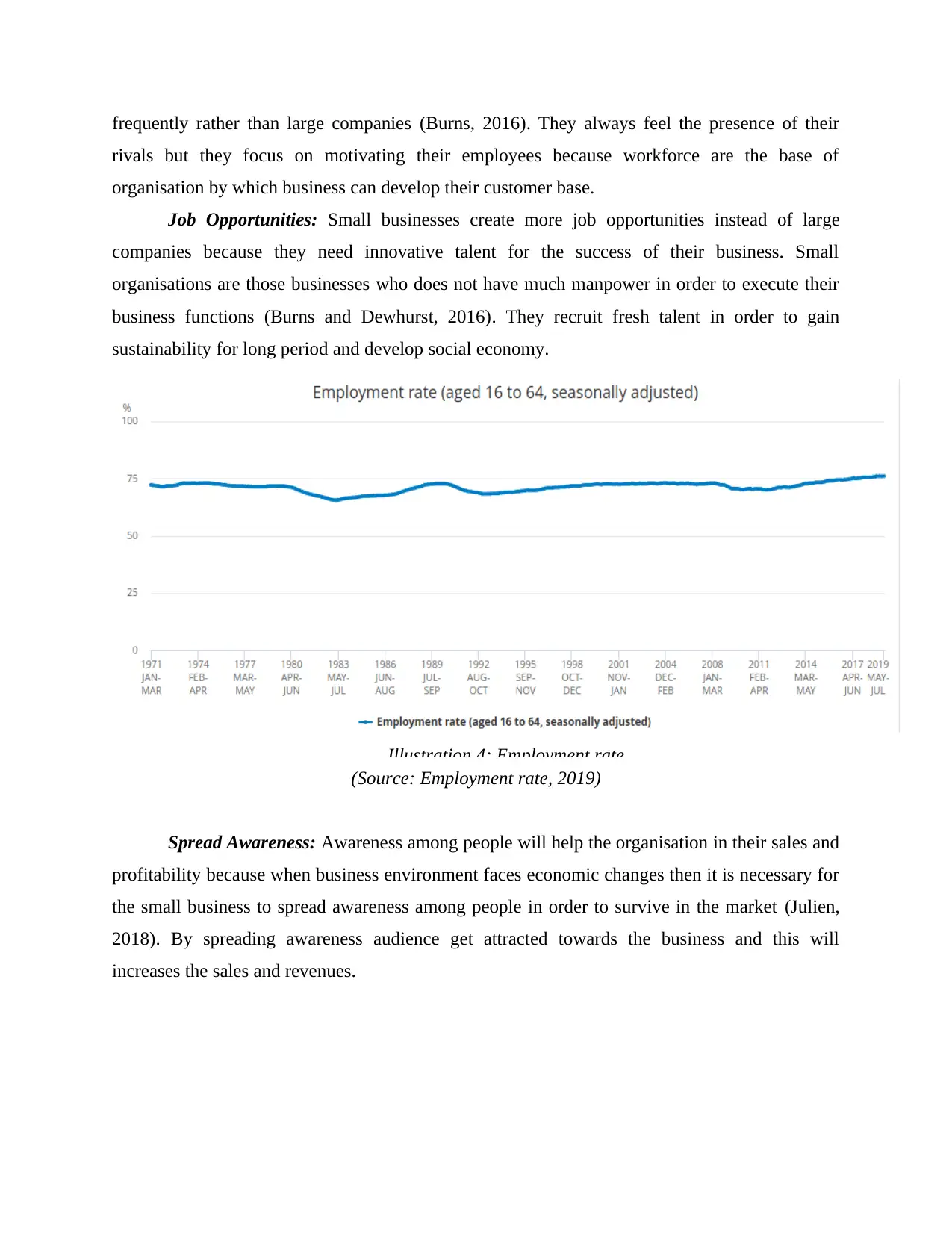
frequently rather than large companies (Burns, 2016). They always feel the presence of their
rivals but they focus on motivating their employees because workforce are the base of
organisation by which business can develop their customer base.
Job Opportunities: Small businesses create more job opportunities instead of large
companies because they need innovative talent for the success of their business. Small
organisations are those businesses who does not have much manpower in order to execute their
business functions (Burns and Dewhurst, 2016). They recruit fresh talent in order to gain
sustainability for long period and develop social economy.
Illustration 4: Employment rate
(Source: Employment rate, 2019)
Spread Awareness: Awareness among people will help the organisation in their sales and
profitability because when business environment faces economic changes then it is necessary for
the small business to spread awareness among people in order to survive in the market (Julien,
2018). By spreading awareness audience get attracted towards the business and this will
increases the sales and revenues.
rivals but they focus on motivating their employees because workforce are the base of
organisation by which business can develop their customer base.
Job Opportunities: Small businesses create more job opportunities instead of large
companies because they need innovative talent for the success of their business. Small
organisations are those businesses who does not have much manpower in order to execute their
business functions (Burns and Dewhurst, 2016). They recruit fresh talent in order to gain
sustainability for long period and develop social economy.
Illustration 4: Employment rate
(Source: Employment rate, 2019)
Spread Awareness: Awareness among people will help the organisation in their sales and
profitability because when business environment faces economic changes then it is necessary for
the small business to spread awareness among people in order to survive in the market (Julien,
2018). By spreading awareness audience get attracted towards the business and this will
increases the sales and revenues.
Paraphrase This Document
Need a fresh take? Get an instant paraphrase of this document with our AI Paraphraser
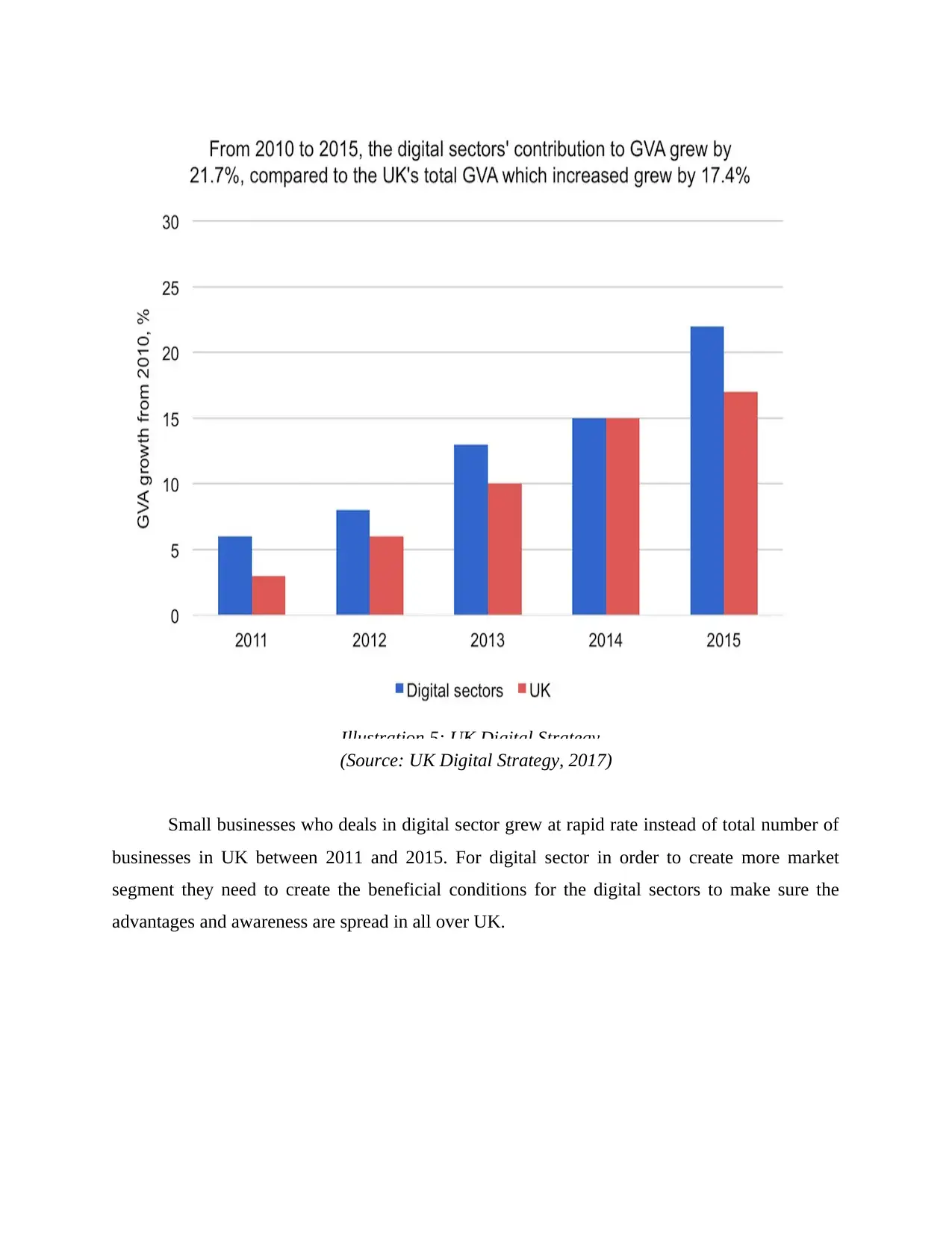
Illustration 5: UK Digital Strategy
(Source: UK Digital Strategy, 2017)
Small businesses who deals in digital sector grew at rapid rate instead of total number of
businesses in UK between 2011 and 2015. For digital sector in order to create more market
segment they need to create the beneficial conditions for the digital sectors to make sure the
advantages and awareness are spread in all over UK.
(Source: UK Digital Strategy, 2017)
Small businesses who deals in digital sector grew at rapid rate instead of total number of
businesses in UK between 2011 and 2015. For digital sector in order to create more market
segment they need to create the beneficial conditions for the digital sectors to make sure the
advantages and awareness are spread in all over UK.
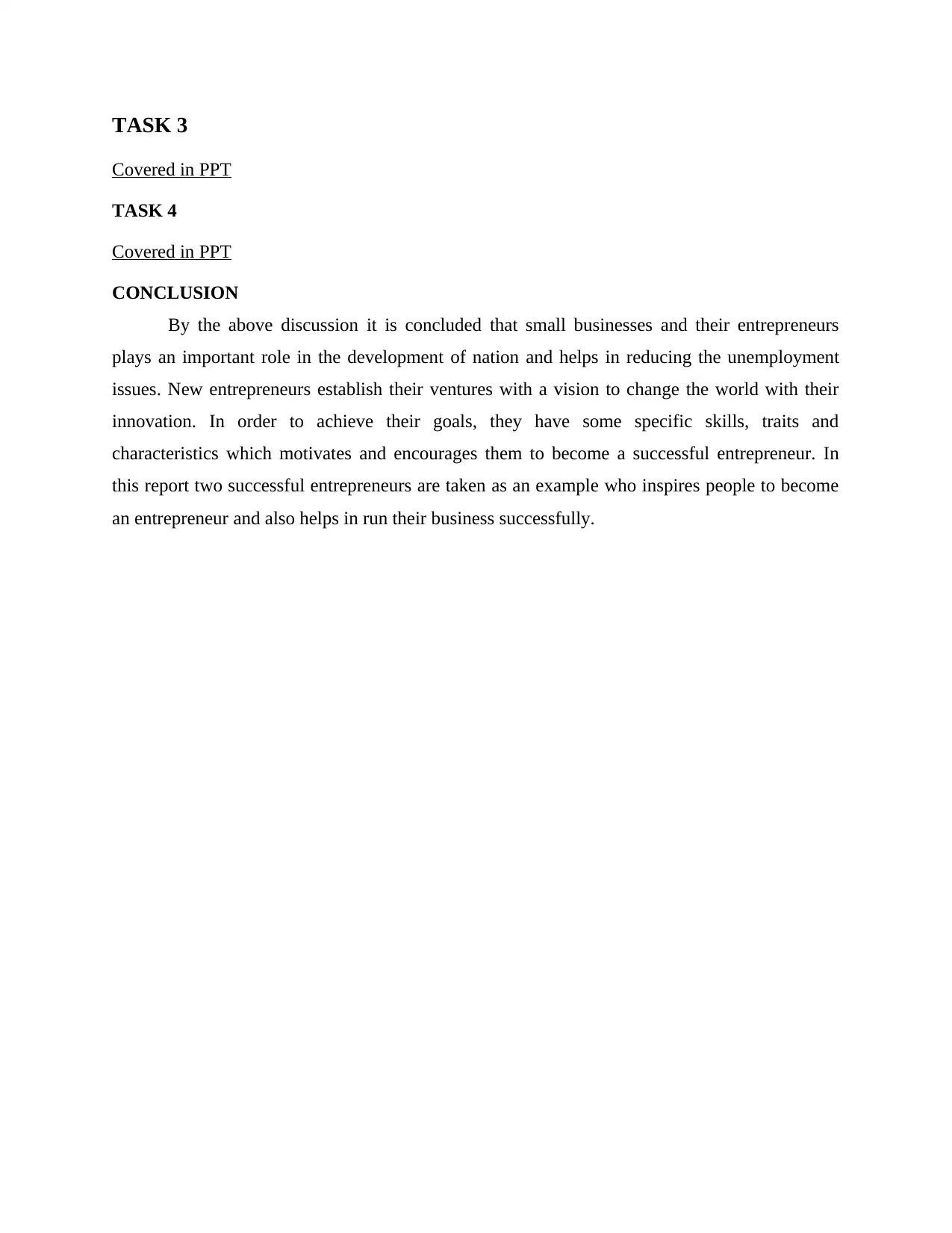
TASK 3
Covered in PPT
TASK 4
Covered in PPT
CONCLUSION
By the above discussion it is concluded that small businesses and their entrepreneurs
plays an important role in the development of nation and helps in reducing the unemployment
issues. New entrepreneurs establish their ventures with a vision to change the world with their
innovation. In order to achieve their goals, they have some specific skills, traits and
characteristics which motivates and encourages them to become a successful entrepreneur. In
this report two successful entrepreneurs are taken as an example who inspires people to become
an entrepreneur and also helps in run their business successfully.
Covered in PPT
TASK 4
Covered in PPT
CONCLUSION
By the above discussion it is concluded that small businesses and their entrepreneurs
plays an important role in the development of nation and helps in reducing the unemployment
issues. New entrepreneurs establish their ventures with a vision to change the world with their
innovation. In order to achieve their goals, they have some specific skills, traits and
characteristics which motivates and encourages them to become a successful entrepreneur. In
this report two successful entrepreneurs are taken as an example who inspires people to become
an entrepreneur and also helps in run their business successfully.
⊘ This is a preview!⊘
Do you want full access?
Subscribe today to unlock all pages.

Trusted by 1+ million students worldwide
1 out of 13
Related Documents
Your All-in-One AI-Powered Toolkit for Academic Success.
+13062052269
info@desklib.com
Available 24*7 on WhatsApp / Email
![[object Object]](/_next/static/media/star-bottom.7253800d.svg)
Unlock your academic potential
Copyright © 2020–2025 A2Z Services. All Rights Reserved. Developed and managed by ZUCOL.





